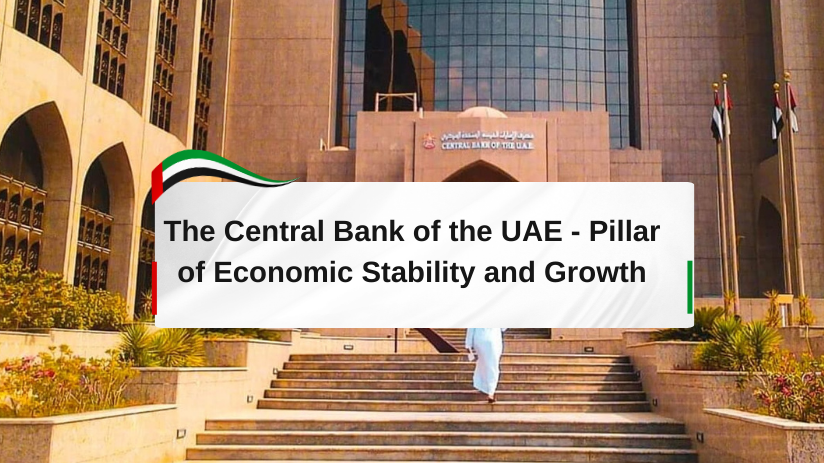The Central Bank of the UAE – Pillar of Economic Stability and Growth
The CBUAE, or the Central Bank of the UAE, ensures financial and economic growth. Also, it maintains the monetary stability of the nation, managing financial institutions. CBUAE was established in 1980. Since then, it has impacted the financial framework of the UAE, adapting to policies around the world and driving sustainable growth.
Historical Background
UAE was initially running with a Currency Board set up in 1973. Its major aim was to forge the national currency, they dirham, after the country was founded in 1971. The dirham, at first, was regulated without giving complete direct control over the chartered policy or the banking system. On December 11, 1980, after determining the need for a foreign exchange system, a robust regulatory framework and controlled monitoring systems were directly enabled in the UAE. Thus, giving the CBUAE crown banking facilities brought forth the power over the regulations that govern the economy, banking system, and fending off monetary instability.
Monetary Policy Implementation: The core function of CBUAE is to steer and create expected results in economic output during elections and loan distribution periods. Policies are laid out and executed to manage interest, total population, currency circulation, work opportunity, and countless others. The commanders of the policies lend monetary assistance when needed, because of that, bouncing back becomes easier.
Currency Issuance and Management: The Central Bank of the UAE has the exclusive right to issue and manage the United Arab Emirates national currency. It is the UAE Dirham, while maintaining its credibility and value.
Banking Supervision and Regulation: The CBUAE supervises and manages all financial companies within the boundaries of the United Arab Emirates. It ensures that they follow proper banking standards and protective measures for depositors and investors.
Financial Stability: The bank observes the risks that are systemic to the financial system, and attempts to control the threats to financial stability.
Government Banking Services: CBUAE acts as the banker to the UAE government for whom it handles government accounts, payment processing, and provides consultancy in finance.
Recent Developments and Initiatives
The Central Bank of the UAE has taken some steps to improve the structure of finance of the UAE and keep it in harmony with the advances made anywhere in the world:
Monetary Policy Adjustments: The CBUAE has responded to the state of the economy by changing the base rate of the overnight deposit facility. For instance, on December 18, 2024, the bank slashed the rate by 25 basis points from 4.65% to 4.40% after the U.S. Federal Reserve cut the rate.
Leadership
Khaled Mohamed Balama is the current governor of the CBUAE as of April 2021. He has considerable experience in banking, financial services, asset management, and investments. Balama’s administration is directed at maintaining monetary and financial stability by managing TESS. It also improves anti-money laundering and counter-terrorism financing policies.
FAQs
What is the primary role of the Central Bank of the UAE?
The responsibilities of the Central Bank of the UAE cover designing and executing the monetary policy. It issues and manages the national currency, overseeing and controlling the financial institutions. CBU ensures the financial stability of the state, and serves as a bank for the government.
When did the Central Bank of the UAE come into existence?
The Central Bank of the UAE was set up on the 11th of December 1980. It succeeded the United Arab Emirates Currency Board which functioned since 1973.
In which ways can CBUAE influence monetary policy?
The CBUAE influences monetary policy through setting the interest rates. It controls the money supply, and implementing actions aimed at maintaining price stability while also supporting economic development.
Who holds the position of the Central Bank of the UAE today?
Khaled Mohamed Balama has been serving as the Central Bank of the UAE’s Governor since April 2021.
What If the CBUAE Guarantees Financial Stability?
CBUAE guarantees financial stability by overseeing systemic risks in the financial system. It takes actions to limit those risks, and controlling financial institutions to ensure compliance with the set standards of sound banking regulation.
Conclusion
The Central Bank of the UAE has played a key role in keeping the country’s monetary balance and economic development in check. The bank’s policies, such as interest rate changes relative to the global economy. It also ensures that the UAE’s financial system is functioning properly. For example, following the US Federal Reserve’s rate cuts towards the end of 2024, the CBUAE reduced its key interest rates by 25 basis points to encourage growth in credit-sensitive sectors such as real estate. Furthermore, other initiatives like the Targeted Economic Support Scheme (TESS) have offered vital assistance for businesses and people. It reinforces the UAE’s perception of a stable and progressive economy. TESS is an example of how the bank has provided important and steadfast aid during the pandemic.



